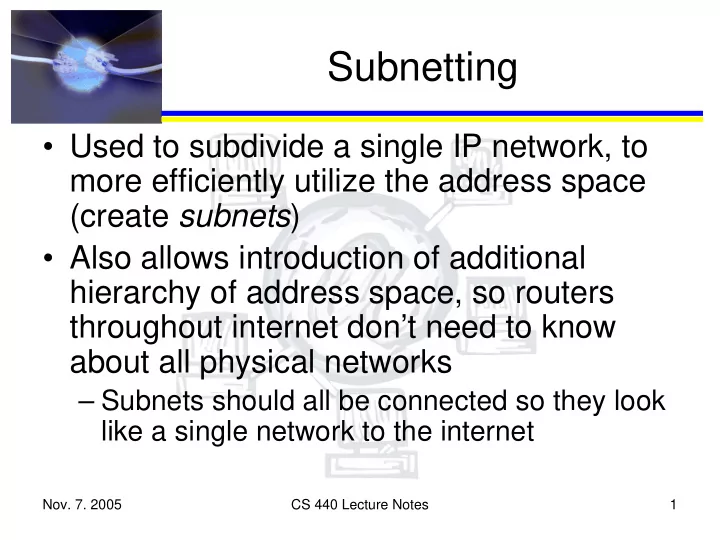

Subnetting • Used to subdivide a single IP network, to more efficiently utilize the address space (create subnets ) • Also allows introduction of additional hierarchy of address space, so routers throughout internet don’t need to know about all physical networks – Subnets should all be connected so they look like a single network to the internet Nov. 7. 2005 CS 440 Lecture Notes 1
Subnetting (cont.) • Create subnets using a subnet mask – The first n bits of the host number are used as the subnet number – All hosts on a physical network must have the same subnet number, and therefore the same subnet mask • Example – use a subnet mask of 255.255.255.192 for a class C network – adds two highest bits of host # to subnet # Nov. 7. 2005 CS 440 Lecture Notes 2
Subnetting (cont.) • Routers outside network can be ignorant of subnets • Routers inside network need to use subnet number and mask to do router, rather than just IP network number • Not necessary for subnet bits to be contiguous in mask, but this should be avoided Nov. 7. 2005 CS 440 Lecture Notes 3
Subnetting (cont.) • Can also put multiple subnets on a single physical network – Will force hosts on network to talk through a router Nov. 7. 2005 CS 440 Lecture Notes 4
Forwarding Messages • Home agent impersonates mobile node using proxy ARP – Sends out ARP messages with its own MAC address and mobile nodes home address, so other nodes on network think home agent is mobile node • Nodes send message to mobile node using permanent home address; home agent receives messages Nov. 7. 2005 CS 440 Lecture Notes 5
Forwarding Messages (cont.) • Home agent forwards message to foreign agent using IP tunneling • Foreign agent unwraps IP message, delivers to the MAC address of mobile node (recorded when mobile node registered on foreign network) Nov. 7. 2005 CS 440 Lecture Notes 6
Eliminating Foreign Agent • Mobile node can function as its own foreign agent, provided it can obtain an IP address on foreign network – Maybe use DHCP – Assigned IP address is used as care-of address • When mobile node sends, it puts its home address in source address; any replies are routed as described Nov. 7. 2005 CS 440 Lecture Notes 7
Route Optimization • Forwarding through home agent can be significant overhead – Suppose mobile node is talking to another node on the same foreign network; every packet to mobile node must go clear to home node and be sent back through IP tunnel to foreign agent – Referred to as “triangle routing problem” Nov. 7. 2005 CS 440 Lecture Notes 8
Route Optimization (cont.) • To resolve, let sending node know care-of address for mobile node – Sending node creates tunnel directly to foreign agent • Home agent sends binding update back to sending node when it forwards a packet – Requires special software in source node – If source understands, it can create entry in binding cache , use this to tunnel message next time it sends to mobile node Nov. 7. 2005 CS 440 Lecture Notes 9
Route Optimization (cont.) • Problem if binding caches become out of date when mobile node moves – Foreign agent can send binding warning if mobile node no longer on network – Sender then removes cache entry, goes back to sending through home agent – Only works if foreign agent is not mobile node • Related area – ad hoc networks Nov. 7. 2005 CS 440 Lecture Notes 10
Recommend
More recommend